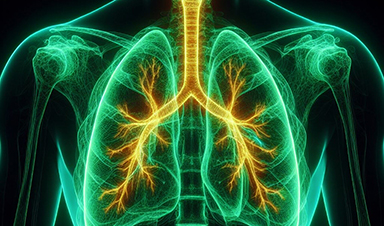Researchers at National Jewish Health have shown that subtle increases in lung scarring, detected by an artificial intelligence-based tool on CT scans taken one year apart, are associated with disease progression and survival in patients with fibrotic interstitial lung disease. The findings, recently published in the American Journal of Respiratory and Critical Care Medicine, suggest that computer-based image analysis may provide an earlier, more objective way to identify patients at highest risk for worsening disease.
“We found that even small increases in fibrosis over one year signal a higher risk of lung function decline and mortality,” said Matthew Koslow, MD, pulmonologist at National Jewish Health and lead co-author of the study. “For example, patients with a 5% or more increase in fibrosis score showed a greater than two-fold increased risk of death or lung transplant and steeper declines in lung function in the following year compared to patients with stable fibrosis scores. What is especially important is that these changes were strongest in patients with less severe disease at baseline —precisely the group where earlier intervention has the greatest potential to alter the course of disease.”
Fibrotic interstitial lung diseases, which include idiopathic pulmonary fibrosis, or IPF, are a group of chronic, progressive disorders marked by lung scarring that make breathing increasingly difficult. Current tools for predicting progression rely on symptoms, lung function tests and radiologist interpretation of high-resolution CT scans—each of which can be limited by subjectivity or variability, especially when evaluating changes over time.
The new study used a deep learning method called data-driven textural analysis (DTA). Developed by the Quantitative Imaging Laboratory at National Jewish Health, DTA provides a precise measurement of the extent of lung fibrosis on CT scans. Researchers found that increases in DTA fibrosis scores over one year were strongly associated with subsequent lung function decline and a higher risk of death or lung transplant.
“This work demonstrates how quantitative imaging and robust statistical modeling can uncover meaningful patterns in disease progression,” said David Baraghoshi, Ph.D., biostatistician at National Jewish Health and co-first author of the study. “By analyzing changes in fibrosis scores over time and linking them to future outcomes, we were able to show that imaging data can serve as a powerful marker of clinical trajectory.”
The results were validated using data from the Pulmonary Fibrosis Foundation Patient Registry, underscoring the generalizability of the findings.
These insights could have major implications for clinical trials and patient care. Quantitative CT analysis may serve as a meaningful trial endpoint, a tool for selecting patients at highest risk, and a guide for treatment decisions in real-world practice.
More information: Matthew Koslow et al, One-Year Change in Quantitative Computed Tomography Is Associated with Meaningful Outcomes in Fibrotic Lung Disease, American Journal of Respiratory and Critical Care Medicine (2025). DOI: 10.1164/rccm.202503-0535oc
News
Vision can be rebooted in adults with amblyopia, study suggests
Temporarily anesthetizing the retina briefly reverts the activity of the visual system to that observed in early development and enables growth of responses to the amblyopic eye, new research shows. In the common vision [...]
Ultrasound-activated Nanoparticles Kill Liver Cancer and Activate Immune System
A new ultrasound-guided nanotherapy wipes out liver tumors while training the immune system to keep them from coming back. The study, published in Nano Today, introduces a biodegradable nanoparticle system that combines sonodynamic therapy and cell [...]
Magnetic nanoparticles that successfully navigate complex blood vessels may be ready for clinical trials
Every year, 12 million people worldwide suffer a stroke; many die or are permanently impaired. Currently, drugs are administered to dissolve the thrombus that blocks the blood vessel. These drugs spread throughout the entire [...]
Reviving Exhausted T Cells Sparks Powerful Cancer Tumor Elimination
Scientists have discovered how tumors secretly drain the energy from T cells—the immune system’s main cancer fighters—and how blocking that process can bring them back to life. The team found that cancer cells use [...]
Very low LDL-cholesterol correlates to fewer heart problems after stroke
Brigham and Women's Hospital's TIMI Study Group reports that in patients with prior ischemic stroke, very low achieved LDL-cholesterol correlated with fewer major adverse cardiovascular events and fewer recurrent strokes, without an apparent increase [...]
“Great Unified Microscope” Reveals Hidden Micro and Nano Worlds Inside Living Cells
University of Tokyo researchers have created a powerful new microscope that captures both forward- and back-scattered light at once, letting scientists see everything from large cell structures to tiny nanoscale particles in a single shot. Researchers [...]
Breakthrough Alzheimer’s Drug Has a Hidden Problem
Researchers in Japan found that although the Alzheimer’s drug lecanemab successfully removes amyloid plaques from the brain, it does not restore the brain’s waste-clearing system within the first few months of treatment. The study suggests that [...]
Concerning New Research Reveals Colon Cancer Is Skyrocketing in Adults Under 50
Colorectal cancer is striking younger adults at alarming rates, driven by lifestyle and genetic factors. Colorectal cancer (CRC) develops when abnormal cells grow uncontrollably in the colon or rectum, forming tumors that can eventually [...]
Scientists Discover a Natural, Non-Addictive Way To Block Pain That Could Replace Opioids
Scientists have discovered that the body can naturally dull pain through its own localized “benzodiazepine-like” peptides. A groundbreaking study led by a University of Leeds scientist has unveiled new insights into how the body manages pain, [...]
GLP-1 Drugs Like Ozempic Work, but New Research Reveals a Major Catch
Three new Cochrane reviews find evidence that GLP-1 drugs lead to clinically meaningful weight loss, though industry-funded studies raise concerns. Three new reviews from Cochrane have found that GLP-1 medications can lead to significant [...]
How a Palm-Sized Laser Could Change Medicine and Manufacturing
Researchers have developed an innovative and versatile system designed for a new generation of short-pulse lasers. Lasers that produce extremely short bursts of light are known for their remarkable precision, making them indispensable tools [...]
New nanoparticles stimulate the immune system to attack ovarian tumors
Cancer immunotherapy, which uses drugs that stimulate the body’s immune cells to attack tumors, is a promising approach to treating many types of cancer. However, it doesn’t work well for some tumors, including ovarian [...]
New Drug Kills Cancer 20,000x More Effectively With No Detectable Side Effects
By restructuring a common chemotherapy drug, scientists increased its potency by 20,000 times. In a significant step forward for cancer therapy, researchers at Northwestern University have redesigned the molecular structure of a well-known chemotherapy drug, greatly [...]
Lipid nanoparticles discovered that can deliver mRNA directly into heart muscle cells
Cardiovascular disease continues to be the leading cause of death worldwide. But advances in heart-failure therapeutics have stalled, largely due to the difficulty of delivering treatments at the cellular level. Now, a UC Berkeley-led [...]
The basic mechanisms of visual attention emerged over 500 million years ago, study suggests
The brain does not need its sophisticated cortex to interpret the visual world. A new study published in PLOS Biology demonstrates that a much older structure, the superior colliculus, contains the necessary circuitry to perform the [...]
AI Is Overheating. This New Technology Could Be the Fix
Engineers have developed a passive evaporative cooling membrane that dramatically improves heat removal for electronics and data centers Engineers at the University of California San Diego have created an innovative cooling system designed to greatly enhance [...]





















